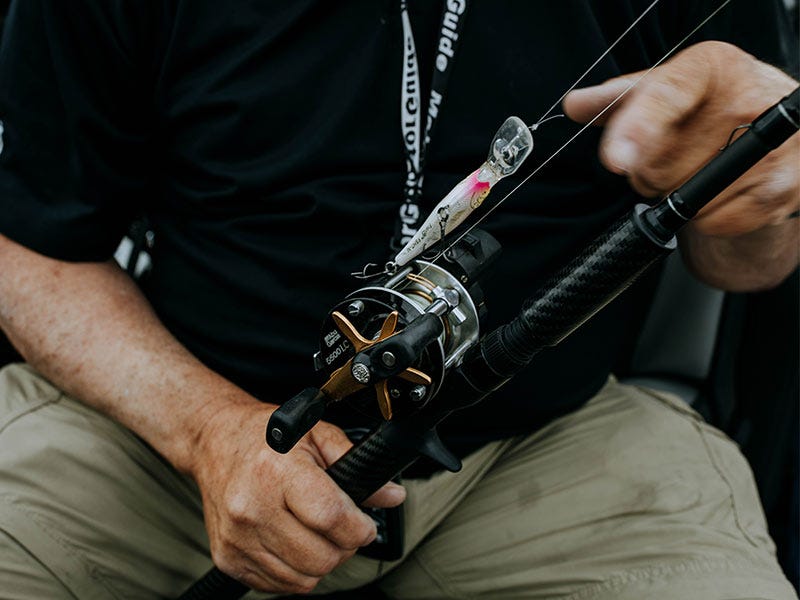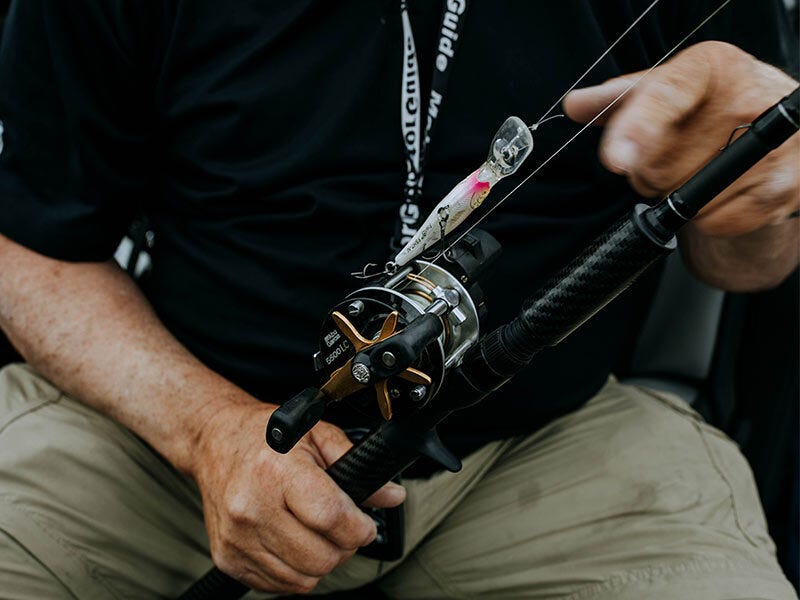What are the Pros and Cons of Different Fishing Lines?


We’ll just state the obvious. Fishing for walleye is just plain fun. Thrilling and fast-paced, catching walleye means an angler has to be quick-thinking when it comes to fishing this predator. That’s why we asked walleye expert, Dale Gilbert, to share his extensive walleye knowledge with us. A walleye master, Dale, has fished walleye from Arkansas to Canada and Michigan to Montana, and he doesn’t disappoint.
When it comes to the pros and cons of fishing lines, it really depends on what you’re fishing. Walleye expert, and sensei, Dale Gilbert explains the difference in lines and his gives his best recommendations for different presentations.
Video Transcription
Different Lines for Different Presentations
I want to talk a little bit about the different lines and basically explain the different things I like to use for the different presentations, and why. And maybe it'll help you get set up with how you want to fish. A lot of it depends on what you're fishing for because if you're fishing for big pike, big northerns or salmon, you may use things a little different than you would for walleyes or for trout. But each line's got its application, and in some cases some are a whole lot better than others. Now, I'm going to talk about what I learned over the last 40 years basically, and tell you what I use for jigging and for rigging, and for cranking. Precision trolling with Leadcore, etc., because again, each one of those things has its advantages.
How the Jigging Line Developed
When I first started out years and years ago with jigging, I used to use what this is called a Berkley Sensation. Actually, it's a hi-vis, they call it the solar. You can kind of see it as a fluorescent green line. This was six pound test. I used this for a lot, a lot of years, and I caught a lot of really big fish with this line. Because when I'm jigging, I like to be able to actually watch and see my line.
This is a monofilament line. Again, has worked really, really well, but I've kind of moved away from that now. About 20 years ago, companies came out with what they called their braid line, their super lines. So there have been quite a variety of Berkley Fireline, and that's actually what I've kind of migrated to. Now, most of my jigging rods are set up with this Berkeley Fireline Ultra Eight in a six pound test. And one of the advantages of the braided lines over the monofilament lines, which have been around forever, is the braided lines are super, super thin. In fact, the six pound test breed has the equivalent of a two pound test monofilament diameter, so it's a lot thinner, which makes it easier to fish in the wind and in current. It's not as affected as much.
Fishing with Fireline
One thing that's maybe a downside to some degree with a fireline is there's absolutely no stress to this line. If you're going to fish with fireline, basically you want to do something that you've got to need to have a really good reel with a smooth drag that doesn't stick. You need a medium to a medium light power rod that's got some flexibility to have some give to it. So what I typically do is I'll use this Berkley Trilene 10 pound XT and I'll put enough backing of this on my reels, whether it's my trolling reels or my jigging reels that we're talking about now. So that I can then fill the spool with 100 to 125 yards of the fireline that I want to use.
Using Fluorocarbon or Your Rig
That way, I don't have to fill the whole spool with the fireline and it's a lot less expensive. And I just have to replace the 100 to 125 yards of the fireline I use. I also then still also use this Berkley Fluorocarbon. Fluorocarbon is one of the newer lines. A couple of things about fluorocarbon; it's got a higher specific density than the monofilament, so it actually sinks, but it's also got a little bit of stretch, not as much as the monofilament. But the other thing that's unique about the fluorocarbon is it's supposedly invisible in the water so you don't have to worry about fish being line shy.
Setting up a Jigging Rod
What I typically do on my jigging rods is I'll put a two or three foot section of this on. I'll put a small bead on the line with a small barrel swivel and then I'll tie about a two or three foot piece of this on. And then I'll tie on the other end of that, the jig or whatever is I'm using here. That way I kind of have the advantage of having a invisible line, and this is 15 pound test that I use. And the reason I use it a 15 pound test leader is because it's a lot more abrasion resistant than the fireline.
When you get into the six two fireline, six pound test, two pound diameter, a little bitty nick in there, the line can break pretty easy. So between rocks and also with northerns that are going to bite you off, the fluorocarbon leader really helps reduce the amount of things that you're going to lose that way because that's a lot more abrasion resistance. So it makes for a really, really good setup and it's what I really ... Over the years I've learned is the best way to set up a jigging rod is to set it up with a backing, a fireline.
Switching from a Tracer to a Carrier
Over the years, I've also used some of this, what they call Berkley Fireline tracer. Tracer is a hi-vis, low-vis line. Every five feet, it changes from a low-vis to a fluorescent green hi-vis. I used that for a lot of years. Just this last year I've gone and switched to this Ultra 8 carrier because it's a lot smoother. It'll cast further, it's also pretty visible. The other line that I use a fair amount is actually Leadcore line. In this case, this is an 18 pound test Leadcore, and basically, Leadcore is a Dacron line that has a lead interior or thing in the side. And I don't know if you can see this, but I've moved this. This is Leadcore line. I've moved the sheath of this back and I pulled out about maybe four inches of the piece of lead here. I'm going to break that piece of lead off.
Advantages of Leadcore Line
And the advantage of the Leadcore line is; I use this for what I would consider precision trolling. Especially with rigs or crankbaits in particular, because of the line diameter and the weight, you can use crankbaits. And with Leadcore line, you can actually get a bait to run a lot deeper than normally it would run because of the weight that's in this line. So as a general rule of thumb with Leadcore, if I let out three yards of Leadcore or three colors of Leadcore, which would be the equivalent of 30 yards because every color is a 10 yard section of line, it'll add five feet to the depth. So say that I want to fish a crankbait down to 20 foot of water, I put out four colors of Lead. I'm going to be in that ballpark.
Now with Leadcore, as I said, it's a Dacron line with a lead interior. So what I do is I'll take this Leadcore line, I'll pull the sheath back about four or five inches here from ... So I've got this piece of lead sticking out, and then I'll break that lead off, let the sheath of that line actually extend back out. So you've actually got the sheath of that line that's got no lead in it sticking out here. And in this case, I take the same 15 pound fluorocarbon leader that I use in my jigging and my other cranking setups. Gently take that fluorocarbon leader, slide it into core of that Dacron sheath line. Slide it all the way in there 'till it goes to the point where you can actually feel it hit the lead that I broke off. So now I've got maybe right there about four inches of that line. It's up inside that Dacron.
Simple Knot on your Line
Do a simple old round knot like so, and then that creates a super, super knot that you can actually reel through your line guides on your rod without a problem. You don't only have to do one old round knot, I generally do two just to be on the safe side, but this knot has worked really, really well. A great way for attaching a leader to a Leadcore that you can roll up through your rides without having an issue. And it's a super, super strong knot that basically, you can pull on that as hard as you want and you literally can't break that knot. I think I've only broke that knot once in my entire life. So super set up for tying a leader to a Leadcore without needing little swivels. It's whatever works really, really well.
One of the things I like to do when I got my lines, my reel is all spooled with new line for this year is I like to take the reels off the rod. And you'll notice that what I've done here is I've taken some of this. It's actually Johnson first aid waterproof tape, and I'll stick a piece of this on the reel seat down here, and then I'll label on there what I've done.
If you've got any questions or need any further information, just stop by any of the North 40 Outfitters stores or check the website at north40.com. Thanks for watching and hope to see you again. Thanks.
